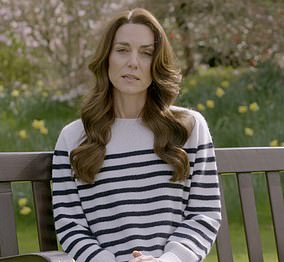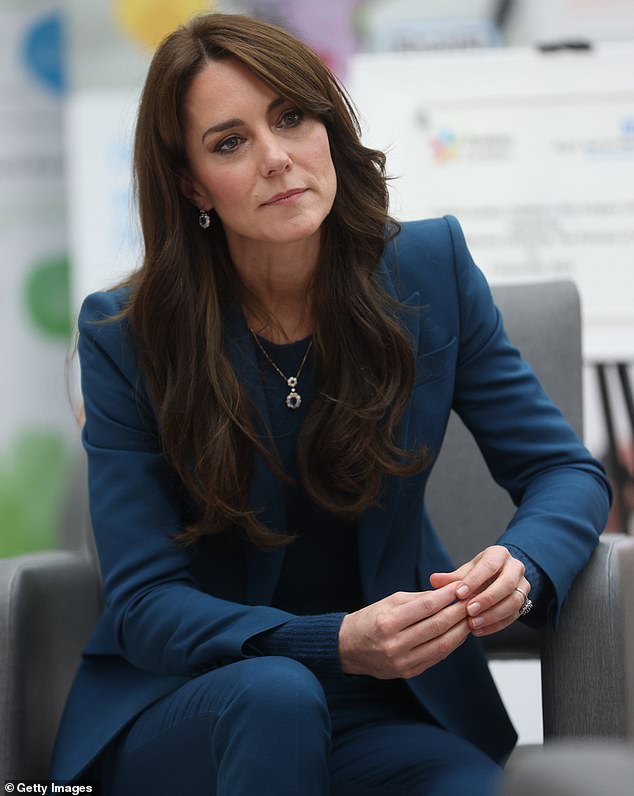
A top oncologist has revealed the potential side effects that the Princess of Wales could have to deal with as she undergoes ‘preventative’ chemotherapy for cancer.
Princess Catherine may have to cope with tiredness, nausea and vomiting as she has treatment against the disease, says Dr Matt Williams.
The future Queen, who could also have issues with her body producing enough red and white blood cells increasing her risk of infection.
Dr Williams, who is a consultant at The London Clinic where Kate underwent major abdominal surgery in January, said she may experience some hair loss depending on the drugs she is taking.
It comes days after the mother-of-three shocked the nation by revealing she had been diagnosed with cancer following the operation and is being given drugs to stop it coming back.
The Princess of Wales pictured at the opening of a day surgery unit in London on December 5, 2023
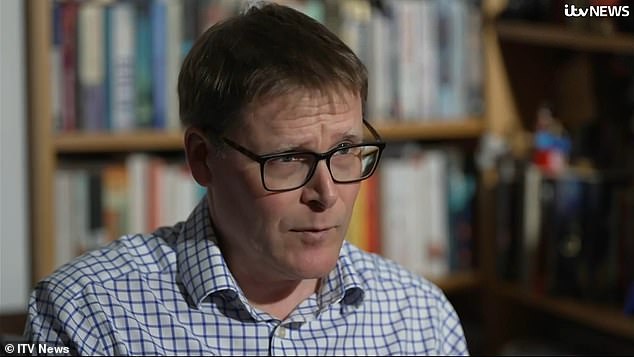
Oncologist Dr Matt Williams told ITV News that Kate can expect side effects of her treatment to include tiredness, nausea and possibly hair loss
The world has rallied around the Princess of Wales since she announced the news in a televised address on Friday evening, with well wishes being sent by thousands.
The 42-year-old revealed doctors had discovered an unspecified form of cancer and she is undergoing ‘preventative’ chemotherapy.
Dr Williams told ITV News that the drugs being taken by Kate will have some impact on her quality of life.
‘The side effects of chemotherapy depend slightly on the drugs you have, but typically include tiredness, nausea, maybe vomiting, problems with blood counts and risk of infection,’ he said.
‘Some people will lose their hair but that’s largely dependent exactly on which drugs you’re using.’
Professor Pat Price, an academic clinical oncologist at Imperial College, said side effects like this are to be expected.
She said previously: ‘These treatments can look like either tablets or they’re drugs that are injected. It depends on the type of cancer and they’re either given all the time or intermittently.
‘They can obviously affect the normal cells in your body as well, so you can get some side effects.
‘Hopefully she’ll be able to manage those and then the chemotherapy will do what it needs to do, and then it will finish and hopefully she will then be fine.’
Also known as adjuvant chemotherapy, the preventative treatment Kate is doing through aims to stop cancer coming back once the main tumour has been removed from the body.
Cancer can spread to other parts of the body, a process called metastasis, where tiny cancerous cells break off the main tumour and take root elsewhere.
These ‘new’ cancers can be hard to detect so medics specialising in cancer treatment, called oncologists, often advise patients to undergo preventative chemotherapy in a bid to eliminate any remaining traces of the disease.
Your browser does not support iframes.
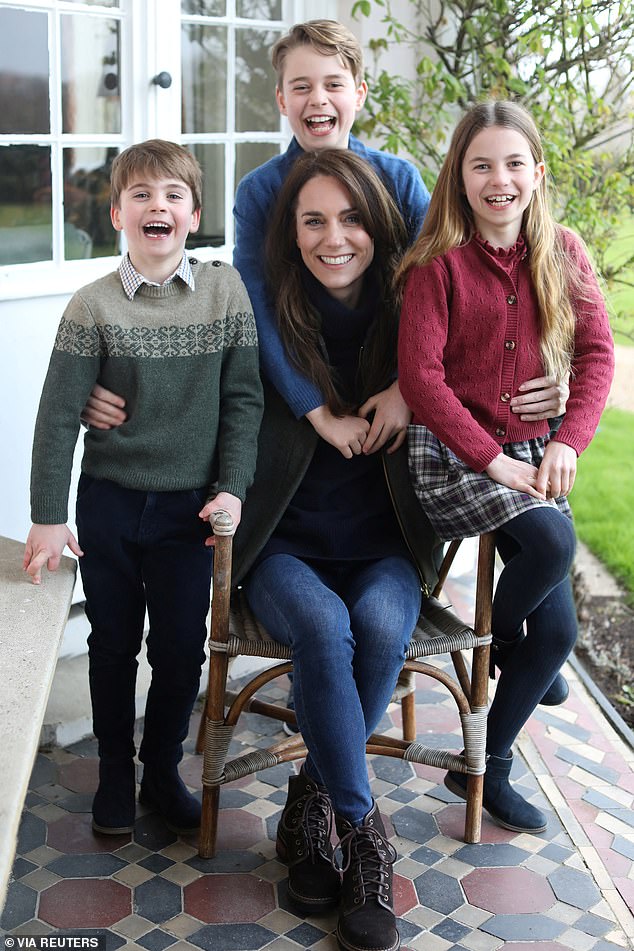
The Princess of Wales with her children in her Mother’s Day portrait, which now has added significance given her diagnosis
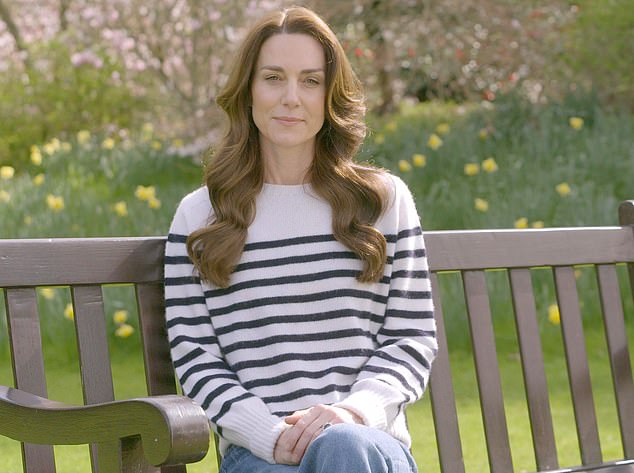
In a video message released on Friday, Kate said she was advised by her medical team to undergo a course of preventative chemotherapy
Preventative chemotherapy is most often delivered as an IV drip or tablets where they are then carried throughout the body by the bloodstream.
Depending on the type, chemotherapy can be administered in either a hospital or at a patient’s home.
There are over 100 types of chemotherapy drugs, but they all work in a similar way and circulate through the blood.
The drugs are cytotoxic, meaning they are toxic to cells and in particular those that divide rapidly.
As cancer cells divide more than healthy cells, they are more affected by chemo, hence why it is used as a treatment for the disease.
However, other types of fast-growing cells, such as hair, bone marrow, skin and the lining of the digestive system are also damaged in the process.
This leads to some of chemotherapy’s famed side effects, such hair loss or thinning, fatigue, bruising and bleeding more easily, increased risk of infection, diarrhoea or constipation, nausea or vomiting, rashes and more.
Often a patient undergoing chemotherapy also take other medication designed to help mitigate or combat some of these symptoms.
The specific dosage and type of chemotherapy used varies depending on the type of cancer.
The effectiveness of preventative chemotherapy varies considerably from patient-to-patient.
Factors that impact it success include the specific type of cancer, when it was originally treated, the age of the patient and if they have any other health conditions.
The specific type of cancer Kate has has not been revealed.
Even though just one in ten cancer cases are in people under the age of 50, experts are warning of an ‘epidemic’ of the disease among younger people.
Your browser does not support iframes.
Your browser does not support iframes.
Your browser does not support iframes.
More than 375,000 cases of cancer are detected every year in Britain, the equivalent of 1,000 each day, according to Cancer Research UK.
UK figures suggest those aged 25 to 49 contribute to around a tenth (9 per cent) of new cases, with almost twice as many women than men in some age groups.
More than a third (36 per cent) of new cancer cases on average are in people aged 75 and over.
Adults aged 50 to 75, meanwhile, account for more than half (54 per cent) of all new cases.
Cancers of the breast, prostate, lung and bowel make-up the overwhelming majority of new diagnoses, accounting for around half in total.
Dr Shivan Sivakumar, an oncologist at the University of Birmingham, said: ‘There is an epidemic currently of young people getting cancer – under 50s.
‘It is unknown the cause of this.’
Professor Andrew Beggs, a consultant colorectal surgeon based at the University of Birmingham, said: ‘Young onset cancer is by no means rare.
‘I run a clinic for early-onset cancer in adults and we are seeing more and more people in their 40s with cancer.’
Professor Lawrence Young, an expert in molecular oncology based at the University of Warwick, added: ‘Cancer survival is generally higher in younger people.
‘Early diagnosis and better treatments is resulting in improved outcomes, with survival rates doubling in the last 50 years.’
Figures suggest around one in two people will develop some form of cancer during their lifetime.
